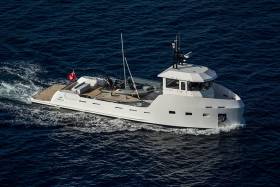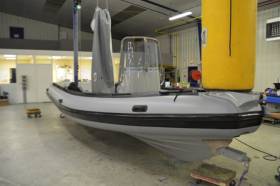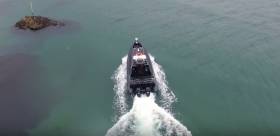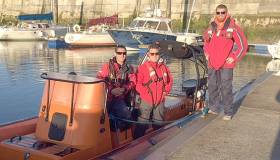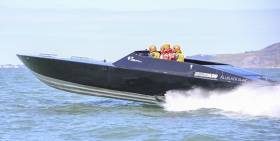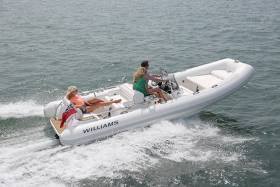Displaying items by tag: Rib
YXT 20m Support Vessel World Debut At Monaco Yacht Show
The YXT 20 was conceived to support power and sailing yachts of any size, or be an explorer yacht, all on her own.
The large 45 square meter open deck can be a comfortable base for a large tender, a sailboat, 2 wave runners, a big RIB, paddle boards, wind surf boards, Sea Bobs, scuba diving gear, submarines, containers, cars or motorcycles and literally tons of storage.
The YXT 20's interiors design is by Franck Darnet of Franck Darnet Design. The yacht was conceived as a support vessel for superyachts ranging from 30 to over 70 meters. The unit is propelled by two 715hp Cummins diesels giving her a range of 900 nautical miles and a 14 knot cruising speed.
YXT 20 support vessel has a white livery, giving her a fresher and more marine aspect. This color scheme also emphasizes the gamma's production philosophy: created for carrying extra toys and gadgets, the vessel's use is closer to the fun and leisure aspects of seagoing (beach club or party deck, even extra accommodation).
A stern mounted gangway davit, allowing use of the transom beach area to carry tenders and jet skis. The stairs and the first four meters of deck are completed in teak, underlining the yachting style of the YXT 20.
LAYOUT
The YXT 20’s design recognizes that different owners have different objectives, so is available in two versions – “High Profile” with extra freeboard and “Low Profile”.
In the High Profile version, the YXT 20 can accommodate eight with four guest in two luxurious guest cabins. In both versions, four crew enjoy comfortable and efficient crew quarters in two twin cabins with galley, stowage and laundry plus one large storage container accessible from
the main deck. It can also be used for extra refrigerator appliances, wine cellars, or when necessary, even an extra accommodation, a spa or a gym. Like any LYNX yacht, owners can customize and make it their own.
DAVITS AND SUPPORT EQUIPMENT
This is the primary characteristic of every support vessel. The YXT 20 features two davits - the primary is located on the main deck, the secondary, which also serves as the gangway, at the stern. The two 360-degree davits have a lifting capacity of 1.7 tons primary, 0.5 at the stern with a 5 meter reach and 360° slewing.
INTERIORS
Guest area and lounge: bulkheads and overheads in natural wood veneer marine grade plywood, parquet flooring. Furnishings in natural wood veneer marine grade plywood.
CREW QUARTERS
Bulkheads in natural wood veneer marine grade plywood, parquet flooring. Furnishings in white laminate veneer marine grade plywood with wood trim.
YXT 20 STORAGE DIMENSIONS AND VOLUME
Hold: 5m x 5m, 25m2
Available volume: apx. 30m3 of stowage with standing headroom Length: 5m
Width at deck level: apx. 5.5m
Centerline headroom: 1.8m/1.95m
Lateral headroom (for storage only): 1.25m
Available storage volume: 30cbm
Yamaha Unveils New Outboards At Southampton Boat Show
Yamaha has more international brands on display than previously to give visitors a greater choice of powered craft and RIBs for a lifestyle afloat at today's Southampton boat show. From WaveRunner PWCs, trailer-boats, high performance RIBs and day-boats to fishing craft and offshore cruisers, Yamaha has something to suit every pocket and performance wish.
Around the show key models from Anytec, Ballistic RIBs, Chaparral (new model), Cobra RIBs, Draco, Finnmaster, Jeanneau, (with new models), Linder, Ribeye (new PRIME model), Rigiflex, Robalo, Sealegs, Whaly, White Shark and Zodiac are on show, with a range of Yamaha outboards from 2.5 to 300hp.
The new portable Yamaha F2.5B, the “baby” of the outboard range, is shown for the first time in the UK with deliveries to dealerships already under way. The new model has lower emissions than the previous 2.5, better performance and even more features which are outlined in the separate release.
Although the Ballistic 4.3m is the smallest of the Ballistic RIBs it still retains the solid build quality and outstanding handling that all Ballistic RIBs are known for. Ballistic RIBs are used by military and law enforcement agencies across the world, including the Metropolitan Police in London, the South African police, the Norwegian police and the Fisheries Protection Service in Sierra Leone. Versions of Ballistic RIBs are also widely used by coastguards, harbour masters and dive clubs.
#Solo - Pictured above is the RIB that French sailor Christophe Maupaté will pilot solo in his quest to set a new Atlantic record from Bordeaux to New York.
Previously attempted by Ireland's own Enda O'Coineen, no one has yet completed a solo transatlantic voyage by RIB.
But as reported on Afloat.ie last December, Figaro veteran Maupaté has been planning his own crossing for some time, having plotted a 4,460-nautical-mile course that will take him from France via Ireland's East Coast, western Scotland, the Faroe Islands and Iceland to the southern tip of Greenland and Canada's Maritimes towards the US – tracing the route of Lafayette's Hermione.
Now Maupaté's record attempt is just weeks away, launching from Bordeaux on Saturday 16 July with a stopover in Dun Laoghaire expected in the first few days.
Irish RIB builders Red Bay Boats launched a new Stormforce 12–metre fitted with twin 350 Verado outboards last week.
According to the Northern Ireland firm, the sleek boat has been built for Better Moments As, based in Norway.
This will be the second Stormforce 12 delivered to the company in the past year. The boat has been loaded and is en-route from Cushendall in County Antrim to Norway for its role in guided wildlife trips in Svalbard.
Three Tralee Bay Sailing Club members set out from Fenit in county Kerry yesterday to retrace a TBSC voyage first made 25 years ago. Ribbers Cian O'Donnell, James Landers and Giles Kelliher set out from the most westerly port in Europe on the 700–mile circumnavigation. Pit stops are planned in Burtonport tonight, then Bangor, Kilmore Quay, Dingle before returning home to Fenit.
Round Ireland Powerboat Record Bid This Weekend
A bid to break the 2009 Round Ireland powerboat record will be made this weekend. Venture Cup entrant John Ryan and his Team Hibernia crew will make an attempt at the record on Sunday. Starting in Kinsale on the South Coast, Ryan and his four man crew will need to be back in the Munster harbour within 19 hours if they are to break the seven–year–old record set in a time of 18 hours 38 minutes and 50 seconds.
Hibernia Racing's 100 mph –ALLBLACK SL44 entry is built for marathon racing and has a range of 500–miles, making it possible for the circumnavigation to be made with just one refuel stop. The sleek aluminium built craft was testing in Cork Harbour a month ago and was powering around Dublin Bay in the past fortnight as preparation for the now cancelled Venture Cup.
The 2009 record holder Philip Fitzgibbon will be part of this weekend's attempt and joins the four–man crew as navigator. Sean McNamara and Denis Dillon complete the line–up.
'We''re going clockwise from Kinsale. I'm keen to get the Atlantic out of the way first', Ryan told Afloat.ie this afternoon.
Fitzgibbon and Mike Shanahan reclaimed their Round Ireland Powerboat Record powering over the Kinsale finish line to become the first team to set a sub 19–hour time for the circumavigation of Ireland in October 2009. The record was set in a 7.5 metre RIB powered by a 250hp engine.
Williams Jets Tenders Invests In Boat Builders of the Future
Oxfordshire-based Williams Performance Tenders in the UK is has announced it will once again be giving local students the chance to take part in its innovative training scheme. Now in its fourth year, the course offers young people a fantastic chance to gain valuable practical experience in the marine industry, as well as have the opportunity to become an apprentice with the global-leading brand.
10 young people from schools in Oxfordshire have been selected to attend the five-week Powerboat Workshop course. The practical sessions, which kick off on 23rd April are designed to give young people the chance to learn life-long skills that can be used in future employment, and to teach them more about the sector where Williams Jet Tenders is recognised as a global leader.
The sessions will culminate in an exciting race day at Williams’ test lake on 21st May. Last year, 10 young people enjoyed a fantastic day racing model speed boats of their own designs on the water, and were also given the opportunity to go for a spin as a passenger in one of Williams’ sporty jet tenders.
One attendee from last year’s event was John Howell, MP for Henley who really enjoyed the event and recognised the value the course can bring to young people in Oxfordshire, commenting: “I was so impressed with last year’s event and what the young people had achieved. This really is a fantastic initiative that Mathew and John have set up that is really giving young people a great chance of a career, as well as investing in the future of the industry. I am looking forward to seeing what the students achieve this year and to another thrilling end of course race.”
As in previous years, one of the participants from the course will also be given the opportunity to start work as an apprentice at Williams – underpinning the brand’s commitment to investing in the boat builders of tomorrow. Two young apprentices are already employed at the factory which continues to grow in response to increased global demand.
The scheme was started by brothers Mathew and John Hornsby, founders of Williams Jet Tenders, and is run in partnership with Employment Action Group.
Mathew Hornsby, Sales Director at Williams Performance Tenders, commented: “It’s always been important to John and I that we help to nurture and invest in the boat builders, designers and engineers of our future. We have been so impressed with the calibre of the students, as well as their dedication and hard work over the past three years, and we have high hopes for the young people taking part this year.
“The apprentices that we’ve hired over the past few years are working out really well and it’s fantastic to see them grow in their role here at Williams. Our past students have all really enjoyed the course, particularly the race day at the end, as it gives them a chance to see everything we’ve taught them about designing and building boats in action.”
Founded by brothers Mathew and John Hornsby in 2004, Williams Jet Tenders has established itself as the world’s leading jet tender specialist, renowned for its range of Turbojet, Dieseljet and Sportjet models. The company is launching a new range in 2016, the MiniJet. Williams Jet Tenders now employs 60 staff at its Oxfordshire base, and is supported by a global team of factory trained engineers.
French Solo Sailor Aims For Atlantic RIB Record
#Solo - French sailor Christophe Maupaté aims to follow in the wake of Ireland's own Enda O'Coineen in his attempt to be the first person to cross the Atlantic solo from Bordeaux to New York by RIB.
The Figaro veteran will set off on 16 July 2016 from Bordeaux heading north, via the Celtic and Irish Seas – including a stop-over in Dun Laoghaire – on an epic voyage that will see him trace a semi-circle around the North Atlantic.
That route takes Maupaté via the Orkneys, Iceland and the southern tip of Greenland to Canada's Maritimes provinces and onward to New York to coincide with a commemorative voyage by a replica of historic French general Lafayette's ship Hermione.
And he'll be doing it all single-handedly in a 7.5m RIB, a custom French-built Zeppelin, equipped with a Suzuki four-stroke outboard motor and Garmin navigation and communication devices.
The Atlantic has been crossed by RIB several times before, most notably by TV adventurer Bear Grylls and team in 2003 from Canada to Scotland, and more recently by the Brown brothers from Florida to London in 2009.
But the closest anyone's come to a solo RIB crossing was Enda O'Coineen, when he helmed the 5.5m Zodiac RIB Kilcullen III from Halifax in Nova Scotia to Dunmore East in the mid 1980s – a voyage recounted in his book The Unsinkable Kilcullen.
There is no Guinness World Record for O'Coineen's feat, so Maupaté aims to be the first into the books with his own incredible expedition of some 4,460 nautical miles.
More details can be found on the official Bordeaux -> New York in Solitare website HERE.
World's Largest Amphibious RIB Launched By New Zealand Boat–Builder
Kiwi boat firm Sealegs International has released its newest and largest amphibious rigid inflatable boat (RIB) to date - the Sealegs Interceptor 9000.
Targeted at commercial and military applications the Interceptor 9000 is powered by a 300hp Yamaha four-stroke outboard motor and is capable of 44 knots at full payload of 700kg.
Complimenting the exceptional bluewater perfomance from its 23 degree 5mm alumnium hull, the Interceptor 9000 is fitted with eight Jolt Rider shock mitigating seats providing exceptional passenger comfort for the most demanding water conditions.
The extra wide 3m beam allows for huge deck space and creates a very stable yet versatile work platform.
The Sealegs system works by having powerful motorised wheels, which give the user a variable on land speed of 0-7km/h (forward and reverse) powered by an on-board 22hp Honda driven hydraulic power pack.
Designed to be rapdily deployed, the Interceptor 9000 can be driven from a storage location or trailer, down a launching ramp or beach and into the water - all with the occupants staying in the boat and remaining completely dry.
Once in the water, the Sealegs wheels are easily retracted into the ‘Up’ position and are completely out of the water. The boat is then driven and used as normal. When approaching land, the Sealegs wheels are lowered into the ‘Down’ position whilst still moving in the water.
Once on land the craft can be lowered until the hull is touching the ground, allowing passengers to disembark safely.
Sealegs CEO David McKee Wright says the new model was developed to meet market demand.
“The Interceptor 9000 gives us a model with the size, passenger count and layout that many commercial and military operators have been asking for in an amphibious craft. It was developed in response to international sales demand and we’re excited at the sales opportunities this new model will bring,” says McKee Wright.
The craft has been developed using the same Amphibious Enablement Kit available to existing OEM boat builders which demonstrate the versatility of Sealegs technology.
The new Sealegs 9m Amphibious Interceptor will be on public display for the first time ever at the Auckland On-the-Water Boat Show from 24th-27th September as part of the Sealegs 10 year celebrations.
Specifications:
Model: Sealegs Interceptor 9000
Length (wheels up): 9m
Beam: 3m
Hull constructions: 5mm Aluminium
Height (wheels down): 2.45m
Dead rise at transom: 23 degrees
Dry weight: 2240kg
Payload: 700kg
Tubes: Hypalon
Fuel Capacity: 250L
Outboard: 300HP
Top speed on water (full fuel and 8 pob): 44 knots
Speed on Land : 7 kph
Sealegs is based in Auckland, New Zealand, where the Sealegs concept of amphibious boating was first invented and where they continue to be manufactured. The majority of the boats are sold and used by customers all over the world and this year’s Auckland on the Water Boat Show marks the celebration of the production of over 1000 boats to 50 countries.
Young south coast boater Adam Brennan is rapidly building a strong reputation for himself within the Irish and UK boating communities.
At just 17, he is still at boarding school in Ireland but has already secured himself a Super Yacht Cadetship with the UK Sailing Association when he leaves school. Alongside his academic career, Adam also manages 12 boats for customers around Kerry during the holidays and advises them on their boating requirements, with Suzuki being the outboard of choice for both his own boats and his recommendations to customers.
In addition to all of this Adam is also the lead organiser of the 'Bull run for fun' which is a 74–nautical mile cruise in company from Kenmare Bay in Ireland to the iconic Bull Rock in the Atlantic. Adam founded this event when he was just 12 years of age and since then it has grown to be one of Ireland's top power–boating events.
Not content with forging a career in the marine industry and organising his own events, Adam is also restoring a Delta Dash 5.5m RIB, which he is re-powering with a Suzuki DF140A outboard motor, which has been generously donated by Suzuki GB. The DF140A benefits from Suzuki's Lean Burn Fuel Control system and will deliver all the power and performance that Adam's RIB needs plus class-leading fuel efficiency.
Whilst Adam is doing much of the restoration work to the RIB himself, he is calling upon the expertise of Suzuki Dealer, Marine Motors in Cork to rig the outboard.
Suzuki's donation of the outboard to Adam is just one of the ways in which it will be participating in the Bull Run for Fun this year, as part of the company's celebrations to mark the 50th Anniversary of its very first outboard motor, the D55, which was launched in 1965.
George Cheeseman, Sales & Marketing Manager for Suzuki GB's Marine Division, said, "When we heard about Adam's activities and superb credentials for someone so young, we were keen to support him. He is incredibly enthusiastic and as such he is a fantastic ambassador for our range of ultimate four stroke outboards."


























